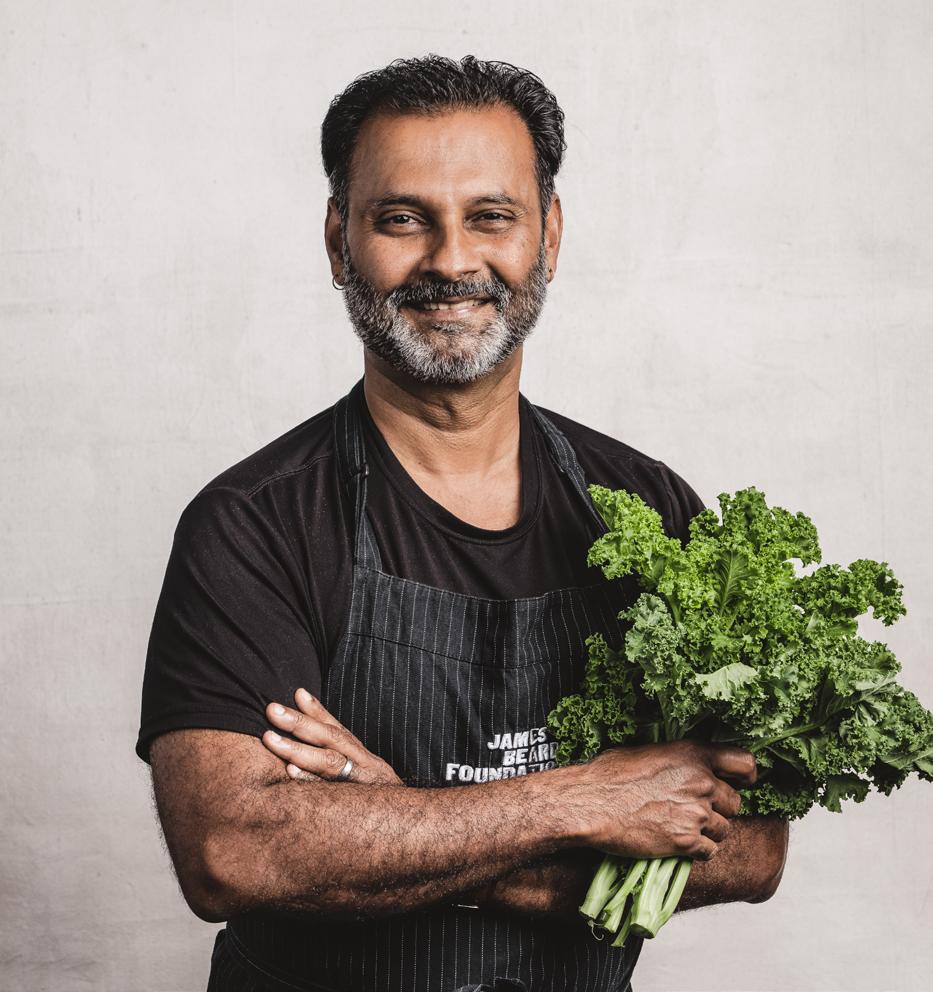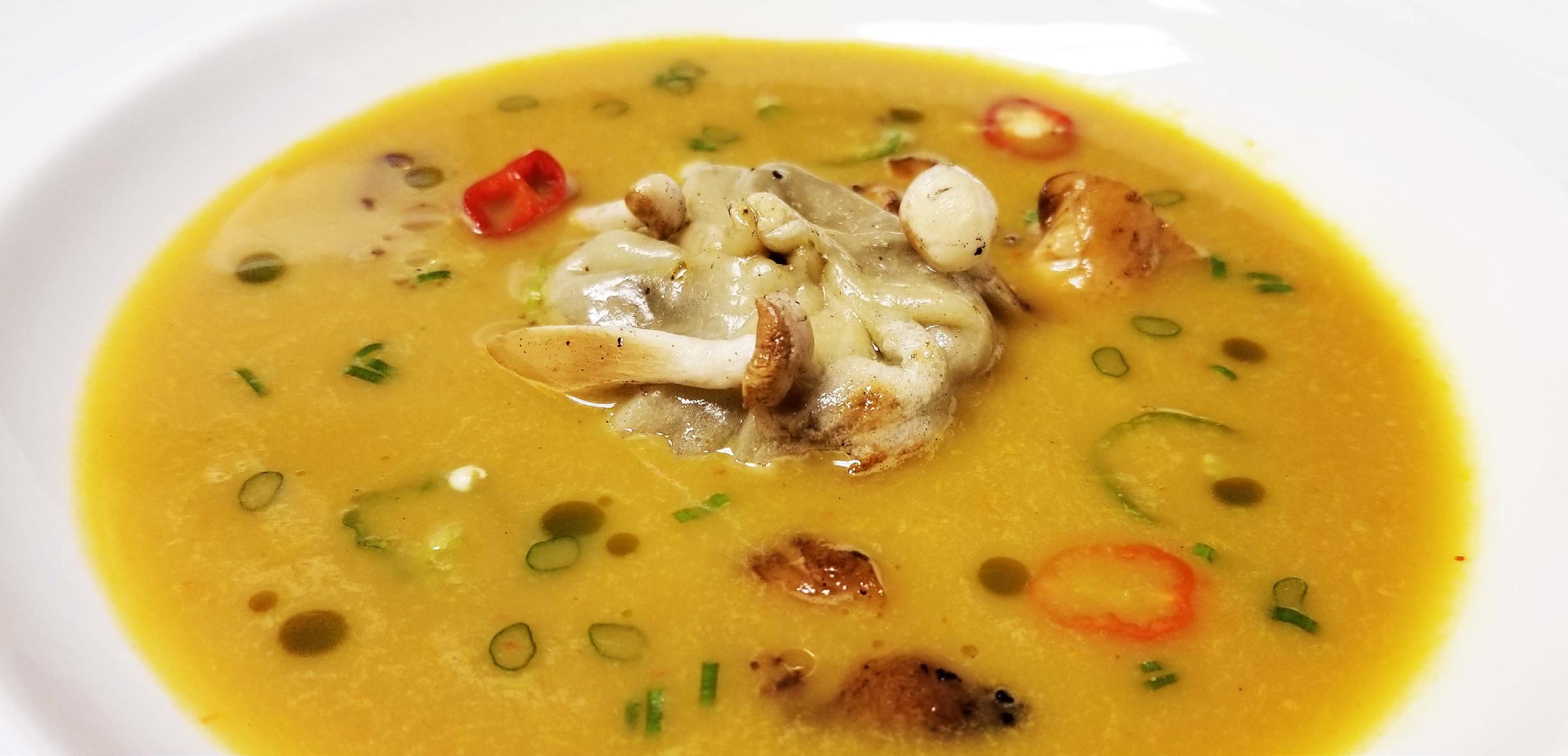
5 minute read
RECIPE
The Highest Peak of Soups
Hari Pulapaka, PhD, WCMC, CEC
Advertisement
Soybeans are an incredible source of plant-based protein yet get a bad rap with environmentalists because they are used to feed livestock, and by many non-vegetarians because its most common processed form, tofu, apparently it tastes like nothing. The trick is to puncture the tofu with a fork and then rubbing on a wet marinade before marinating for an hour or two, preferably overnight.
This recipe I created utilizes edamame and reminds me of the time my wife, Jenneffer, and I arrived at 4 am on Tiger Hill near Darjeeling to await the sunrise and unobstructed views of Mt. Kanchenjunga and Mt. Everest — the world’s 3rd highest peak and highest peak, respectively. After drinking Darjeeling tea accompanied by Parle biscuits, we visited a tiny shack on the way back to the hotel where we were served warm momos and clear thukpa.

Himalayan Dumpling and Noodle Soup
Makes approximately 4 tasting servings
INGREDIENTS
2 cups shelled edamame (soybeans), cooked in lightly salted water
2 medium onions, slice one thinly, mince the remaining onion
2 tablespoons garlic, minced
2 tablespoons ginger, grated
1 teaspoon serrano or jalapeno, sliced thinly
1/2 cup carrot, sliced thinly
1 tablespoon low sodium soy sauce
few drops of honey
1 teaspoon Szechuan peppercorns, coarsely crushed
1 teaspoon turmeric powder
1/2 teaspoon red chile powder (like cayenne)
2 tablespoons olive oil, more or less
1 cup unbleached all-purpose flour
1/3 cup warm water, more or less
1 quart vegetable stock
1 medium length daikon radish, peeled and spiralized (or use a mandolin and shave into long strips)
1 tablespoon rice wine vinegar
2 cups assorted mushrooms, lightly salted, and roasted salt & pepper, in stages and per taste
DIRECTIONS
Edamame Momo
Filling & Make-Up: Sauté the minced onion, half the ginger, half the garlic, and half the green chilies over medium heat for about 5 minutes. Season with salt and pepper. Cool it down in a bowl and add the turmeric, red chile powder, and one cup cooked edamame. Either by hand or in a food processor, pulse the mixture a few times to both mix and break down the mixture to a uniform consistency. Taste and re-season as desired.
The Dough: In a bowl, add some salt to the flour and mix well. Make a well in the flour and add half of the water and bring the dough together gently, without kneading too much. Add more water if it is too dry. Once the flour and water come together, knead the dough for a couple of minutes to a smooth texture. Place the dough in an airtight container (or a plastic bag, making sure to press out any air). Let the dough rest at room temperature for about an hour.
Form 1 inch balls of the dough and roll out to a 4 inch diameter disks, using just enough water to prevent sticking. Place a tablespoon of filling in the center of the disk, moisten the edges of the disk with water and either bring them in to a point or crimp them to a decorative, fanned look not unlike pie dough. Bring water to a boil and using either a traditional bamboo steamer or a perforated pan, steam the momos for 30 minutes or until the dough is completely opaque and glistens. Make 12 momos for four servings. Hold warm.
Szechuan Thukpa
Heat half the olive oil and add the Szechuan peppercorns. Cook for about a minute to infuse the oil with the peppercorn flavor. Next add the sliced onions, remaining ginger and garlic and sauté for 2 minutes. Next add the green chiles. Cook for 30 seconds and add the vegetable stock. Simmer for 5 minutes before adding the soy sauce and honey. Taste and adjust the seasonings as desired.
Doodle (Daikon Noodle)
Soak the spiralized daikon and hold in lukewarm water for 15 minutes. The doodles are ready to be used. When ready to use, drain well and mix in a tablespoon of rice wine vinegar.
To serve each portion, in a bowl, place a portion of zoodles, three steamed momos, steamed edamame, some extra roasted and sauteed mushrooms, fresh cilantro, and pour over warm thukpa.
Born and raised in Mumbai, India, Hari Pulapaka came to the United States to pursue a graduate degree in mathematics. A professional midlife crisis led him to enroll fulltime in culinary school while continuing his academic career, adding professional chef and restauranteur to his resume. Today Hari continues his dual professional life, as a Worldchefs Certified Master Chef, a 4-time James Beard Award semifinalist for Best Chef in the South, and an Associate Professor of Mathematics at Stetson University. The founder and CEO of the the Global Cooking School, Pulapaka is the author of Dreaming in Spice, A Sinfully Vegetarian Odyssey.










